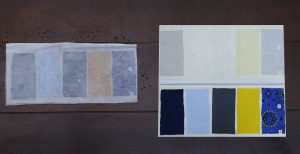Color Fastness
It’s a big disappointment to spend hours on an embroidery project, just to have the colors run when you wash it. The term “fast” refers to the permanence of the thread’s color under different conditions. “Lightfast” means the color will fade more slowly when exposed to sunlight. “Colorfast” means the dye won’t run when exposed to water. Colorfast is the ability of a fabric or other substances to keep the same color without fading or running even if washed, placed in harsh light, exposed to perspiration, or treated with certain chemicals.
How To Test For Color Fastness
Before you begin on a big project, test your fabric and threads for color fastness. Testing for color fastness before sewing clothing is especially important when your item will be washed over and over. Imagine if you made a beautiful red and white spotted dress with a white ruffle and the red ran all over the ruffle after the first wash. Disaster! It would be awful if all your hard work sewing or an expensive item was ruined in the first wash. Ideally, you should always pre-wash your fabrics.
Not just to test for their color fastness but also to pre-shrink. The more (and hotter) the water is the more likely a color will be to run. If threads will be exposed to wet conditions, you need to be extra sure every color of every thread is color.If Pre-Washing Fabric Is Not Possible, Here Is How You Can Still Check For Color Fastness
Cut small pieces of your fabric and sew them onto a piece of white fabric roughly double in size;
Fold the white fabric in half so the colored fabrics are sandwiched in the middle;
Wet the fabrics thoroughly the way you wish to wash your final sewn item. This may be in hot water or cold water and with or without soap. Generally hot water with soap results in the greatest color transfer;
Leave your test color fastness fabric for half an hour still folded up.
Color Fastness – Problem Solving
As far as colorfastness is concerned, there are things you want to think about before you purchase your embroidery thread to begin with. The best way to make your embroidery thread colorfast is to buy embroidery thread that claims to be colorfast from the outset. While there can still be bleeding issues with colorfast embroidery thread, buying embroidery thread that claims to be colorfast will give you a big leg up.
Making Threads More Colorfast
There are two methods you can use at home to make your threads more colorfast. Sometimes one works, sometimes the other.
Vinegar is a great and inexpensive fixative. Make a bath with one-part white vinegar to three-parts water. Let the thread soak for a while and then rinse thoroughly. Many dyers do this to their threads. It doesn’t hurt the threads and fixes almost all dyes.
Add a tablespoon of salt to the wash. When it comes out from the dryer, the color vibrancy could pleasantly shock you. The chloride in the salt acts as a sealant for the colors and prevents their running.
For threads that have excess dye solution in them, try rinsing them under cool running water. If they are a washable fiber, you could also wash them with baby shampoo. Rinse until the water is clear.
Only do this with threads where you are pretty sure there is excess dye. If the color gets lighter, excess dye isn’t the problem — you need to do the vinegar treatment. Test a small scrap for color fastness before you dunk your whole fabric into either salt or vinegar.
Colorfast Fabric And How It Affects Your Laundry
Learning about colorfastness in clothes is important to your success. Some learn through a terrifying experience of discovering an entire load of white clothes has been turned pink by a red sock. Or, a favorite light-yellow blouse has turned green by traveling through the washer with a new pair of blue jeans. Or the dark thread colors are all over the white fabric after the first wash.
Do The Colorfastness Test
One easy way to test if a fabric is colorfast is to dampen a clean, white cloth. Rub the wet cloth on an interior seam or hem of a colored garment. If any color comes off onto the white cloth, then the item is not colorfast and the dye will run when the garment is washed.
For a more thorough test for specific detergents and laundry products, use the following tips:
Mix one teaspoon of the laundry product (detergent, stain remover, chlorine bleach, or oxygen bleach) with 1/2 cup of warm water. Stir well to mix and be sure that any powdered formulas are completely dissolved.
Turn to an interior seam or hem. If you are concerned that the solution will bleed through to the right side of the fabric, place a dry, white cotton cloth under the test area.
Dip a cotton swab in the solution and dab it onto the test area.
Blot the area with a white paper towel. If the color comes off onto the white paper towel, the fabric will bleed dye. If the color of the test area has changed or become lighter, the dye will bleed.
If you have a garment with different colors (strips, color-blocks, or graphic print),test each colored area separately.
Recommendation For Care
Have you ever bought a beautiful garment, worn it, looked at the care label symbols and thrown it in the laundry basket promising a hand wash that never happens? All laundry symbols have a specific meaning so, we have put together an essential guide that you can use today to maximize the lifetime of your most prized threads.
International care labeling code is based on 5 basic symbols. Washtub (Washing), Triangle (Bleaching), Iron (Ironing), Circle (Dry cleaning) and the Square (Drying).General guidelines – that are applicable across fabrics anywhere
If no water temperature or dryer setting is mentioned, it is indicative that it is safe to use any setting, even hot water and hot tumble drying.
If no ironing instructions are given, it means that it should not be necessary to iron the garment. If ironing is needed to preserve the garment’s appearance, instructions must be given. The label need not mention any ironing temperature if the regular use of a hot iron will not harm the garment.
If bleach is not mentioned, any type of bleach may be used, when needed. If bleach is unsafe, then the label must say “no bleach” or “do not bleach.” If non-chlorine bleaches are safe, then the label should say “use only non-chlorine bleach when needed.”
If no warnings are given, no adjustments are needed to the care process listed on the label.
If the label says do not dry-clean, don’t assume you can. The type of dry-cleaning solvent does not have to be specified if all are safe. If not, the particular solvent to be used should be listed. A “Dry-clean” label means you can use a coin-operated machine. “Professionally dry-clean, short cycle, tumble warm” means you cannot since a coin-operated machine could not be adjusted to follow the process.
Washing
-
Your item can be washed in the washing machine if your care label has a tub symbol.
-
The number on the tub symbol indicates the maximum temperature that can be applied.
-
The more bars underneath the tub indicates a reduction of spinning and rinsing:
-
No bar: The item can be spun and rinsed as normal.
-
1 bar: Spin speed should be reduced.
-
2 bars: Mild wash but can be spun and rinsed as normal.
-
If there is a cross over the tub symbol you should not wash the item.
Bleaching
Before you turn to your bottle of bleach to make your whites shine like they used to, it’s worth taking a look at your garment’s fabric care label and as well as the embroidery thread that is used to see if the clothing can handle bleaching agents.
If you see an empty triangle, that means you can safely use bleach on your piece of clothing when necessary. Diagonal lines inside the triangle refer to the use of non-chlorine bleach, however in the case when the triangle is crossed out by two lines, you shouldn’t use bleach at all.
Drying
-
If the care label has a circle inside a square, your item can be tumble dried.
-
The more dots on the iron symbol suggests the temperature of heat that can be applied:
-
-
1 dot = low temperature
-
2 dots = medium temperature
-
3 dots = high temperature
-
If there is a cross over the tumble dry symbol, you should not tumble dry the item.
-

Ironing
-
-
Your item can be ironed at any temperature if the care label iron symbol has no dots.
-
The more dots on the iron symbol suggests the temperature of heat that can be applied:
-
-
-
-
-
1 dot: delicate i.e, silk and wool.
-
2 dots: synthetics.
-
3 dots: linen and cotton.
-
If there is a cross over the iron symbol you should not iron the item.
-
-
-

Conclusion
Colorfastness is an important quality of embroidery thread. Learning how to test your fabrics and threads for color fastness may seem daunting and difficult at first, but it is such an important step to preserve your fabric and embroidery design.
-






